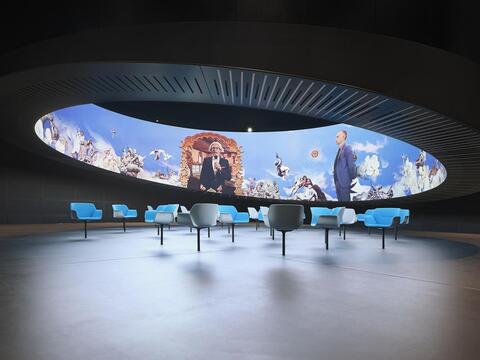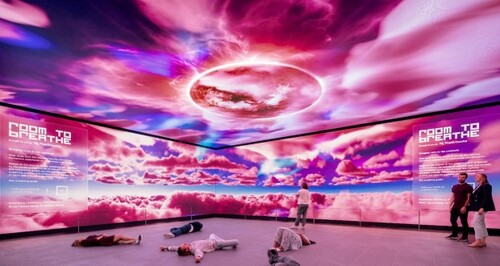
Indoor LED display screen: between square inches, showcasing the charm of technology
In the era of digital wave surging forward, indoor LED display screens are like brilliant pearls, shining brightly in various indoor spaces with their unique charm, bringing unprecedented visual feast and information exchange experience to people.

1. Visual feast, perfect fusion of color and image quality
Indoor LED displays, with their excellent display performance, have become an excellent tool for creating immersive visual experiences. A high-resolution screen can present extremely delicate images, with every detail clearly visible, making the audience feel as if they are there. Whether it’s colorful advertising videos, stunning movie clips, or lifelike art displays, LED displays can accurately reproduce colors and achieve high contrast visual effects, showcasing the charm of content to the fullest.
Its excellent color expression ability is even more admirable. Through advanced color calibration technology, LED displays can present rich and vivid colors, with a wide color gamut coverage and natural and smooth color transitions. From deep ocean blue to blazing flame red, from fresh emerald green to soft pink, every color is full and vivid, bringing a visual feast to the audience.
2. Flexible and versatile, suitable for diverse indoor scenes
Indoor LED display screens have extremely high flexibility and adaptability, and can be customized according to different indoor spaces and usage needs. Whether it’s a large commercial shopping center, a luxury hotel banquet hall, a small conference room, or an exhibition hall, LED displays can easily blend in and become the finishing touch of the space.
In the commercial field, LED display screens can serve as an important carrier for advertising and promotion, installed in prominent locations such as the atrium, elevator lobby, and corridors of shopping malls, attracting customers’ attention and increasing brand awareness and product sales. Through dynamic advertising displays and interactive experiences, LED displays can bring consumers a brand new shopping experience, enhancing interaction and stickiness between consumers and brands.
In the field of culture and art, LED displays can be used for stage performances, art exhibitions, and other occasions, bringing more stunning visual effects to the audience. By perfectly combining with stage lighting, sound effects, and other elements, LED displays can create a fantastic stage atmosphere, taking the audience into an imaginative world. In art exhibitions, LED displays can present static art works in a dynamic and three-dimensional form, allowing audiences to appreciate the details and connotations of the works from multiple perspectives, opening up new avenues for the dissemination and appreciation of art.
In the field of education, indoor LED displays also play an important role. The display screens installed in classrooms and lecture halls can clearly display teaching materials, video materials, and other content, making knowledge transmission more intuitive and vivid. Teachers can use display screens for multimedia teaching, enriching teaching forms and enhancing students’ interest and participation in learning. Students can also watch teaching demonstrations more clearly, better understand and absorb knowledge.

3. Intelligent interaction, opening up a new way of information communication
With the continuous advancement of technology, indoor LED displays have gradually acquired intelligent interactive functions, bringing revolutionary changes to information transmission and communication. Through interactive technologies such as touch and gesture recognition, users can interact in real-time with the display screen, query information, and operate applications, achieving more convenient and efficient information acquisition and processing.
In smart conference rooms, LED displays can seamlessly integrate with conference systems, enabling remote video conferencing, file sharing, online collaboration, and other functions. Attendees can display and explain conference materials by touching the display screen, making real-time annotations and comments to improve the efficiency and quality of the meeting. At the same time, the display screen can also be personalized according to the needs of the attendees, such as adjusting the display mode, volume size, etc., to provide a more comfortable environment for the meeting.
In the field of public services, such as airports, stations, hospitals, etc., the intelligent interactive function of LED displays can provide more convenient services for passengers and patients. Passengers can check flight information, train schedules, map navigation, etc. by touching the display screen; Patients can inquire about the distribution of hospital departments, expert information, registration and payment, greatly improving the efficiency and convenience of services.
4. A model of energy conservation, environmental protection, and green technology
In today’s era of advocating green environmental protection, indoor LED displays have become a model of energy conservation and environmental protection due to their low energy consumption and long lifespan. Compared with traditional display devices, LED displays use advanced semiconductor light-emitting technology, which significantly reduces energy consumption and can save users a lot of electricity expenses.
At the same time, the service life of LED displays can reach tens of thousands of hours, reducing the frequency of equipment replacement and minimizing the generation of electronic waste, making them more environmentally friendly. Moreover, LED display screens also pay attention to environmental protection concepts in the production process, using environmentally friendly materials and processes to reduce pollution to the environment.
Its energy-saving and environmental protection characteristics not only meet the requirements of sustainable development in today’s society, but also significantly reduce long-term operating costs for enterprises and institutions. In large shopping malls, office buildings, and other places, numerous indoor LED display screens continue to operate. If traditional display devices are used, energy consumption will be a huge expense, and using LED display screens can effectively control costs.

5. Future outlook: Integrating innovation and expanding infinite possibilities
With the continuous development of cutting-edge technologies such as 5G, artificial intelligence, and the Internet of Things, the future of indoor LED displays is full of infinite possibilities.
I. Integration with 5G technology
5G technology has the characteristics of high speed, low latency, and large capacity, which will bring smoother content transmission to indoor LED displays. For example, on indoor display screens in large sports venues, real-time high-definition footage of the event can be played, making the audience feel as if they are in the midst of the arena. At the same time, 5G can also support the connection of more devices, achieve linkage display between multiple display screens, and create more stunning visual effects.
II. Artificial Intelligence Empowerment
Artificial intelligence can bring more intelligent content display and interactive experience to indoor LED displays. Through technologies such as image recognition and speech recognition, the display screen can automatically adjust the displayed content according to the audience’s behavior and needs. For example, in a shopping mall, when customers approach the display screen, it can automatically recognize their gender, age, and other information, and push suitable product advertisements and discount information. In addition, artificial intelligence can also achieve automatic generation and optimization of content, improving the efficiency and accuracy of information dissemination.
III. Expansion of IoT applications
The development of the Internet of Things will make indoor LED displays an important component of smart buildings. The display screen can be interconnected with other smart devices to achieve information sharing and collaborative work. For example, connecting with environmental sensors to automatically adjust the brightness and color of the display screen based on indoor lighting, temperature, and other conditions; Linked with the access control system, display welcome messages or related notifications when personnel enter or exit.
In short, indoor LED displays rely on their excellent display performance.
